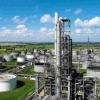Sir,
Can anyone help me to size thermal releif valve for heat-exchangers(to safe-guard the heat-exchanger tubes)
Case scenario:
Hot vapour is entering the shell side of the heat-exchanger & tube-side valves are closed.
Whatever liquid available in tubes will expand/vapourize.
i want to design thermal releif valve for this scenario.
How to calculate the releif qty & valve sizing?
Thanx for ur suggestion.
Regards,
bhaskaran
|
|
Thermal Releif Valve For Heat-exchangers
Started by bhaskaran, Dec 10 2007 10:36 PM
5 replies to this topic
Share this topic:
#1

Posted 10 December 2007 - 10:36 PM
#3

Posted 11 December 2007 - 07:33 AM
bhaskaran:
Before you can design a proper relief device, you have to accurately define the scenario.
You state you want to size a “thermal relief valve”, yet you proceed to describe a situation where the shell-side vapor is hot enough to vaporize the liquid in the tubes. What is taking place? Thermal expansion or vaporization?
If the shell-side vapor is hot enough to vaporize the tube side, why do you call it a heat exchanger and not a vaporizer? Just what is really taking place?
If you only have thermal relief required – which is nothing more than liquid expansion pressure due to heatup – then that doesn’t normally require a calculation. However, if you are indeed vaporizing in the tube side, then you may even have 2-phase flow.
I think this process description of yours requires more of an accurate and detailed explanation before you start applying something we think you meant. Can you be more detailed and specific in your description to allow a complete analysis of what is really happening?
#4

Posted 12 December 2007 - 06:59 AM
Sir,
Let me explain the scenario cleraly.
A condenser where
shell-side - solvent vapours from distillation column
Tube-side - Cooling water circulation
Manual valves are provided in inlet & outlet of cooling water.
Case-1:
Suppose oulet valve is closed & hot solvent vapours are coming in shell-side,the tube-side water will vapourise.Releif system is required to safe-guard tubes.
Case-2:-
If inlet & oulet valve is closed & shell -side no operation.Then due to heat of radiation water in tube-side will expand.Releif system is required here.
Question:
i)Whether a 1" thermal relif valve will holds good for the aove scenario (or) safety valve to be designed
ii)Whether any calulation is available?
Thanx in advance.
Regards,
haskaran.r
Let me explain the scenario cleraly.
A condenser where
shell-side - solvent vapours from distillation column
Tube-side - Cooling water circulation
Manual valves are provided in inlet & outlet of cooling water.
Case-1:
Suppose oulet valve is closed & hot solvent vapours are coming in shell-side,the tube-side water will vapourise.Releif system is required to safe-guard tubes.
Case-2:-
If inlet & oulet valve is closed & shell -side no operation.Then due to heat of radiation water in tube-side will expand.Releif system is required here.
Question:
i)Whether a 1" thermal relif valve will holds good for the aove scenario (or) safety valve to be designed
ii)Whether any calulation is available?
Thanx in advance.
Regards,
haskaran.r
#5

Posted 12 December 2007 - 07:19 AM
QUOTE
Case-1:
Suppose oulet valve is closed & hot solvent vapours are coming in shell-side,the tube-side water will vapourise.Releif system is required to safe-guard tubes.
Suppose oulet valve is closed & hot solvent vapours are coming in shell-side,the tube-side water will vapourise.Releif system is required to safe-guard tubes.
Will it? This would depend on the pressure in the tubes, wouldn't it? If I had a PSV protecting the tubes set for say 150 psig I would have to heat the water to almost 366 F to get it to boil! What you need to do is first determine what that PSV set pressure is then see if you can boil the water.
But saying this, you most definitely need a PSV IF you want to protect the tubes from a possible rupture due to thermal expansion. Note that there is no code that says you have to do this (I would though).
Now, if the water was hot enough to boil at the PSV set pressure, then determining the PSV size is more complicated. We typically just put in a minimimal size PSV, 1/2" x 1" or 3/4" x 1" without doing any calculations. But for vaporization you would then need to deternine the vaporization rate and perform the proper sizing. Gettng the vaporization rate is nothing more than a heat transfer calculation.
Case 2 is a moot point if you are going to protect the tubes from the scenario described in Case 1.
#6

Posted 12 December 2007 - 11:59 AM
bhaskaran,
In earlier response, i have referred you to read has describe the fire scenario and the relief scenario can change from pure liquid to two phase and further to gas relief...
First of all, you needs to study your system and determine potential relief scenario. Mr. Montemayor clearly explained about this.
Secondly, Phil has provided you some hints on determining the relief scenario and practical approach...
I still think that information you have provided is insufficient to tell you exactly what will happen and how you should tackle the issue.
Can you please
- provide basic parameter such as operating and design condition for shell side and tube side
- and base on your data and advices from Mr. Montemayor and Phil, make assessment on relief scenario and tell us what your think...
I am sure Phil (and/or Mr. Montemayor) will take it up from your thought and further advise you...
JoeWong
In earlier response, i have referred you to read has describe the fire scenario and the relief scenario can change from pure liquid to two phase and further to gas relief...
First of all, you needs to study your system and determine potential relief scenario. Mr. Montemayor clearly explained about this.
Secondly, Phil has provided you some hints on determining the relief scenario and practical approach...
I still think that information you have provided is insufficient to tell you exactly what will happen and how you should tackle the issue.
Can you please
- provide basic parameter such as operating and design condition for shell side and tube side
- and base on your data and advices from Mr. Montemayor and Phil, make assessment on relief scenario and tell us what your think...
I am sure Phil (and/or Mr. Montemayor) will take it up from your thought and further advise you...
JoeWong
Similar Topics
Steam Pressure In Heat ExchangerStarted by Guest_mvanrijnbach_* , 15 Apr 2025 |
|

|
||
Thermal Oil Pump Motors Blew OffStarted by Guest_lizelle_* , 02 May 2025 |
|

|
||
Critical Pressure For Choke Valve SizingStarted by Guest_Sherif Morsi_* , 07 Nov 2017 |
|

|
||
Heat Exchanger Steam FlowStarted by Guest_aliebrahem17_* , 25 Nov 2024 |
|

|
||
Check Valve FailureStarted by Guest_Falah_* , 26 Mar 2025 |
|

|

 FB
FB








